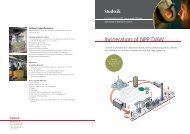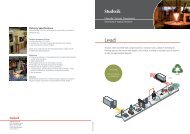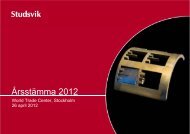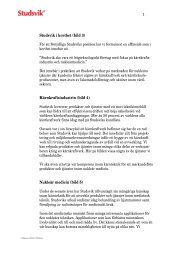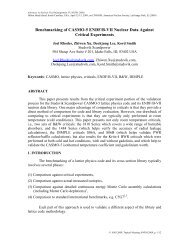Robust PCI Monitoring During PWR Operation at ... - Studsvik
Robust PCI Monitoring During PWR Operation at ... - Studsvik
Robust PCI Monitoring During PWR Operation at ... - Studsvik
- No tags were found...
You also want an ePaper? Increase the reach of your titles
YUMPU automatically turns print PDFs into web optimized ePapers that Google loves.
Proceedings of 2010 LWR Fuel Performance/TopFuel/WRFPMOrlando, Florida, USA, September 26-29, 2010Paper 097fuel performance perspective are maximum localconcentr<strong>at</strong>ed clad hoop stress and maximum local cladcrack length.Clad Hoop Stress - is the stress th<strong>at</strong> forces a crack inthe clad wall to “open up” and propag<strong>at</strong>e through thecladding. Form<strong>at</strong>ion of a crack is a prerequisite to<strong>PCI</strong> and is therefore an ideal indic<strong>at</strong>ion of thesusceptibility of a fuel pin to <strong>PCI</strong> failure. However,<strong>PCI</strong> failure will not necessarily occur only byform<strong>at</strong>ion of the crack by itself.Fig. 2. Threshold <strong>PCI</strong> Model using LHGR d<strong>at</strong>aConversely, once the LHGR is above the thresholdand then begins to decrease, the threshold and <strong>PCI</strong>viol<strong>at</strong>ion limits begin to decrease or de-condition.The drawback with this particular model for <strong>PWR</strong>s isth<strong>at</strong> the threshold level, the <strong>PCI</strong> viol<strong>at</strong>ion limit delta, andthe conditioning & de-conditioning r<strong>at</strong>es are not typicallysupplied from the fuel vendor. They can be determinedfrom detailed thermo-mechanical fuel performancecalcul<strong>at</strong>ions or via experimental d<strong>at</strong>a. Additionally,detailed neutronic d<strong>at</strong>a of the actual LHGR's duringoper<strong>at</strong>ion has previously been difficult to obtain.II. C. Detailed Thermo-Mechanical FuelPerformance AnalysisWhen the LHGR of a fuel pin increases, the fuel pinbecomes prone to a failure mechanism known as <strong>PCI</strong>. Thespecific mechanism is referred to as stress corrosioncracking (SCC) and occurs <strong>at</strong> the inner wall of the fuel pincladding. Although the power increase causes a differentialthermal expansion in the fuel clad, which in turn gener<strong>at</strong>esa tensile stress in the cladding (hoop stress), a certain finalpower level is also necessary for failure to occur.This behavior implies th<strong>at</strong> a high temper<strong>at</strong>ure in thefuel, leading to the release of chemically aggressive fissionproducts (such as iodine), is also required for <strong>PCI</strong>. Thefailure is not immedi<strong>at</strong>e, suggesting th<strong>at</strong> the crack has todevelop and propag<strong>at</strong>e until the crack length is gre<strong>at</strong>er thanthe cladding thickness, requiring th<strong>at</strong> the fuel pin be <strong>at</strong>power for a certain period of time.Clad Yield Stress - the point <strong>at</strong> which the m<strong>at</strong>erialmoves from elastic to plastic deform<strong>at</strong>ion, i.e., doesnot "recover" when the stress is removed. In thisanalysis the difference in the calcul<strong>at</strong>ed clad hoopstress to clad yield stress, or margin to clad failure, isused. The clad yield stress limit is dependent on thefuel design and conditions during plant oper<strong>at</strong>ion.Clad Crack Length – Once a crack has formed in theclad wall, the length and growth of the crack is adirect indic<strong>at</strong>ion of the potential for a <strong>PCI</strong> failure.However, the failure threshold occurs when thecalcul<strong>at</strong>ed crack length exceeds the clad wallthickness.It is important to note th<strong>at</strong> the clad hoop stress andclad crack length are very much dependent on theirradi<strong>at</strong>ion history (LHGR vs. exposure) as well as thelocal LHGR of every fuel pin. Therefore, a full powerhistory (LHGR vs. time) of every fuel pin for the entiretime it has been in the reactor core must be modeled as partof the <strong>PCI</strong> assessment. (Note this is for Zircaloy clad fueland is not necessarily applicable for other claddingm<strong>at</strong>erial.)The deficiency with this approach has been in itsapplic<strong>at</strong>ion; typically only the most limiting pins from acore neutronic simul<strong>at</strong>ion are selected for this morethorough fuel performance analysis. This brings intoquestion the criteria used to select the candid<strong>at</strong>e pins.<strong>During</strong> an actual oper<strong>at</strong>ional transient it is very difficult toset inclusive criteria to ensure the most limiting pins arecorrectly chosen. As with the other methods, until now,there has not been an efficient way to perform this morerobust assessment during plant oper<strong>at</strong>ions.Therefore, in order to properly assess vulnerability to<strong>PCI</strong> due to local power changes, the key indic<strong>at</strong>ors from a





